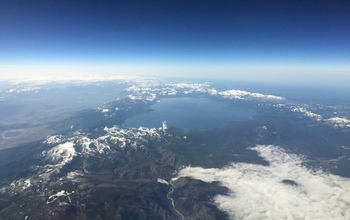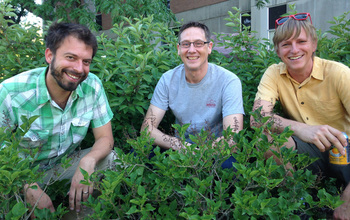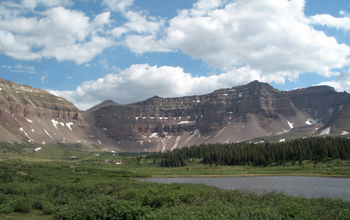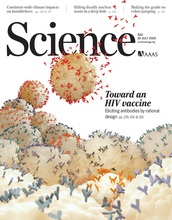All Images
News Release 15-074
Where does water go when it doesn't flow?
Study shows how much enters air from plants, soil, surface water
This material is available primarily for archival purposes. Telephone numbers or other contact information may be out of date; please see current contact information at media contacts.

A serene view of Bear Lake in Utah's Unitas Mountains shows several signs of Earth's water cycle.
Credit: Stephen Good
Download the high-resolution JPG version of the image. (783.1 KB)
Use your mouse to right-click (Mac users may need to Ctrl-click) the link above and choose the option that will save the file or target to your computer.

Clouds and haze are evident in this aerial photo of Lake Tahoe on the California-Nevada border.
Credit: Gabriel Bowen
Download the high-resolution JPG version of the image. (2.1 MB)
Use your mouse to right-click (Mac users may need to Ctrl-click) the link above and choose the option that will save the file or target to your computer.

Scientists Stephen Good, David Noone and Gabriel Bowen among plants, important in the water cycle.
Credit: Eileen Miller
Download the high-resolution JPG version of the image. (2.8 MB)
Use your mouse to right-click (Mac users may need to Ctrl-click) the link above and choose the option that will save the file or target to your computer.

Henrys Lake in Utah's Unitas Mountains; water on land evaporates from lakes, streams and soils.
Credit: Stephen Good
Download the high-resolution JPG version of the image. (864.0 KB)
Use your mouse to right-click (Mac users may need to Ctrl-click) the link above and choose the option that will save the file or target to your computer.

Artist's depiction of the Aura satellite orbiting above Africa; it collected data on water vapor.
Credit: NASA
Download the high-resolution JPG version of the image. (2.8 MB)
Use your mouse to right-click (Mac users may need to Ctrl-click) the link above and choose the option that will save the file or target to your computer.

The researchers' findings are described in the July 10, 2015, issue of the journal Science.
On the cover: A goal in HIV research is to design a vaccine that will protect against the rapidly mutating virus. Such a vaccine would elicit B cells to produce broadly neutralizing antibodies with a high affinity for the HIV envelope protein. Pictured here are B cells displaying colored antibodies; the shades of blue represent unmutated versions. Over time, the right mutations take place to create the lineage of the sought-after antibody (lineage depicted by orange-red gradient). This happens in some HIV patients naturally, but now scientists have immunized animals with engineered immunogens that prime a first step on the antibody mutation pathway. See pages 139, 154, 156.
Credit: Illustration: Valerie Altounian/Science
Download the high-resolution JPG version of the image. (341.2 KB)
Use your mouse to right-click (Mac users may need to Ctrl-click) the link above and choose the option that will save the file or target to your computer.


